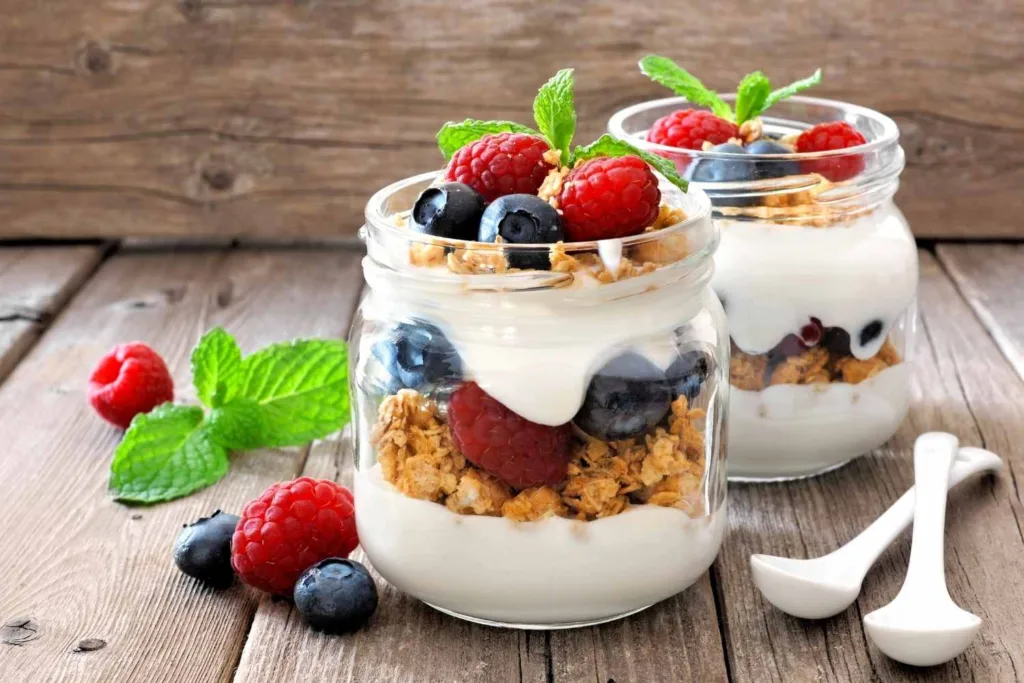Indulging in desserts doesn’t have to derail your weight loss goals. With mindful choices and moderation, you can enjoy sweet treats while still losing weight. This post will explore how to balance desserts with nutrition and exercise for successful, sustainable weight loss.

Introduction
Desserts get a bad rap in the dieting world. We’re told to avoid sugar at all costs and that eating sweets will lead to failure. But desserts aren’t the enemy. When consumed in moderation as part of a healthy diet, desserts can be incorporated into effective weight loss plans.
The key is balancing indulgence with nutritious choices. Allowing yourself to satisfy cravings in small portions prevents the urge to binge later. It’s about being intentional with sweets instead of trying to avoid them completely. This post will discuss strategies for keeping desserts in your diet without disrupting your weight loss progress.
We’ll cover mindful eating techniques, healthier baking substitutions, the role of exercise, and how to choose nutritious dessert options. You’ll learn how sweets can complement your diet when chosen wisely. Let’s debunk the dessert myth and uncover how treats can be part of your sweet success.
The Role of Desserts in Weight Loss
Many dieters believe eliminating all sweets is necessary for shedding pounds. But this restrictive mindset often backfires. Depriving yourself of all desserts can create a vicious cycle of intense cravings, eventual bingeing when willpower runs out, and guilt afterwards.
It’s important to acknowledge that cravings for sugary foods are normal. Our brains are wired to enjoy desserts, as sugar provides quick energy. Eliminating sweets completely can be challenging both physically and psychologically. The key is not avoiding desserts, but managing cravings sensibly.
Allowing occasional, small servings of sweets is preferable to strict restriction. When you know dessert is coming after dinner, it’s easier to exercise portion control. You become less likely to obsess over sugar and make impulsive decisions that sabotage your diet.
Planning modest amounts of desserts into your diet is a smarter approach than total avoidance. With mindful indulging and measured portions, you can satisfy your sweet tooth without going overboard on calories.

Healthy Dessert Swaps
Traditional desserts like cake, pie, cookies and ice cream are loaded with sugar, refined carbohydrates and calories. But there are many ways to lighten these treats and add nutrition. With simple ingredient swaps, you can still enjoy sweets while losing weight.
For example, applesauce is a great substitute for oil in baked goods. It reduces fat and calories while adding fiber and nutrients. Other fruit purees like banana and pumpkin work well too. Cutting all-purpose flour with whole wheat or almond flour boosts protein and further reduces calories.
Sweeteners like maple syrup, honey and coconut sugar contain nutrients absent from white sugar. Greek yogurt and avocado make excellent creamy, tangy ice cream swaps. And blending bananas or avocado with cocoa powder produces a delicious chocolate pudding or mousse.
Check out these healthier recipes:
- Baked Apples with Greek Yogurt and Granola
- Chocolate Avocado Mousse
- Banana Oat Cookies
- Pumpkin Maple Cheesecake Bars
With simple substitutions, you can still create tasty desserts that satisfy your cravings, while providing more nutritional value.
Mindful Eating and Desserts
Mindful eating means paying close attention to what, when, why and how much you eat. Practicing mindfulness with dessert helps prevent overindulging and emotional eating. Here are some useful techniques:
- Slow down – don’t rush through dessert. Savor each bite.
- Plate small portions, such as a square or two of chocolate.
- Avoid eating directly from packages, which leads to overconsumption.
- Notice how the dessert looks, smells, feels and tastes. Appreciate the experience.
- Recognize urges to continue eating past fullness. Stop when satisfied.
- Reflect on how the dessert made you feel. Avoid labeling foods as “good” or “bad”.
Mindfulness trains you to become more conscious of physical and emotional cues around eating. You become less likely to overdo it with dessert when paying attention. Limit portions but fully enjoy – no guilt required.

Incorporating Desserts into a Balanced Diet
A healthy, balanced diet should provide adequate nutrition without unnecessary restrictions. The principles are simple – emphasize fruits, vegetables, whole grains, lean protein and healthy fats. Limit sodium, added sugars and saturated fat.
You can easily fit modest amounts of dessert into this framework. Just balance them out over the course of each day or week. Pay attention to appropriate serving sizes. And carefully choose the types of desserts you eat by assessing nutritional value.
It may help to track calories and nutrients in your diet to ensure you’re not overdoing it on sweets. But don’t stress about having something small like a square of dark chocolate each day, for example. Moderation, variety and balance are key.
Many experts recommend eating dessert shortly after a main meal. This helps prevent overindulging later when cravings intensify. Immediately following dinner, for instance, is a sensible time for a small treat.
Nutritional Value of Dessert Ingredients
Not all desserts are created equal when it comes to nutrition. Some ingredients provide more benefits than others. Here is how some common dessert components stack up:
Fruit – Excellent source of vitamins, minerals, antioxidants and fiber. Choose fresh or frozen.
Dark chocolate – Contains antioxidants and may improve heart health when eaten in moderation. Pick products with at least 70% cocoa.
Greek yogurt – Provides protein and calcium. Choose unsweetened or lightly sweetened.
Oats – Great source of fiber, which promotes satiety and weight loss. Look for whole oat varieties like steel-cut or rolled.
Nuts – Packed with protein, fiber, vitamins and minerals. Limit portions though, as high in calories.
Coconut – Provides healthy fats and fiber. Coconut sugar and flour are less processed alternatives.
Avocado – Nutrient dense with healthy fats, fiber and vitamins. Contains less sugar than other fruits.
Eggs and milk – Contain protein, vitamins and minerals. Pick unsweetened varieties if flavored.
Pay attention to nutrition labels on packaged foods. And limit excessive amounts of white flour, white sugar and unhealthy fats that lack nutrients. Prioritizing nutritious ingredients will help keep your diet balanced.
How Exercise Impacts Desserts
Physical activity is essential for weight loss and burning excess calories. It’s especially key if you want greater flexibility in your diet, including desserts. You can’t out-exercise a bad diet, but activity creates more wiggle room.
Aim for 150 minutes of moderate exercise like brisk walking each week. This could be 30 minutes a day, 5 days a week. Strength training twice a week is also recommended. Don’t overdo it – start slow if new to exercise.
The more active you are, the more calories you burn both during workouts and by boosting your metabolism. This allows you to occasionally indulge in dessert without gaining weight. Just don’t drastically increase portions or frequency.
Interestingly, exercising regularly has also been found to reduce cravings and appetite. So staying active may mean desserts become less tempting and something you desire only occasionally.
After an intense workout, a moderate treat is fine. Good options include Greek yogurt with fruit, cottage cheese with berries, or a protein shake with peanut butter. Just don’t undermine your hard work by bingeing on empty dessert calories.

Conclusion
We all love desserts, and you don’t have to fully give them up for weight loss success. With a balanced diet, activity level, mindful eating habits and healthier substitutions, you can lose weight while still enjoying the occasional treat.
Sweets and indulgences have their place. Just make sure they’re planned and modest. Savor each bite, opt for nutrition-packed recipes, and balance with whole foods the majority of the time.
With the strategies in this post, you now have a blueprint for satisfying your sweet tooth while achieving your health goals. No more associating desserts with guilt or sabotage. Let your cravings guide you to mindful decisions instead of restrictive ones.
Here’s to enjoying both sweet treats AND success on the scale! Stick with the tips here and you’ll be losing weight while still sparing room for dessert.
A Note to Readers
Thank you for reading! I hope you found this article on balancing desserts with weight loss helpful. Be sure to subscribe to my free newsletter for more tips on health, nutrition, weight management, and wellness strategies.
I invite you to explore the many informative posts on food, exercise, mental health, and creating healthy habits here on my site. My goal is providing actionable content to help you live your best, healthiest and happiest life.
Wishing you the sweetest of successes!
Thank you for reading this post, don't forget to subscribe to our free newsletter
!
